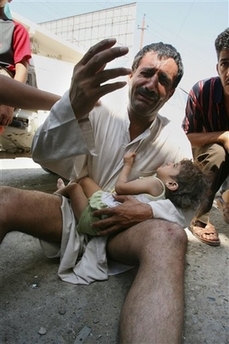Washington - Military commanders in Iraq are developing a plan to move as
many as 5,000 US troops with armored vehicles and tanks into Baghdad in an
effort to quell escalating violence, defense officials said Thursday.
As part of the plan, Defense Secretary Donald H. Rumsfeld on Thursday
extended the tours of some 3,500 members of the 172nd Stryker Brigade Combat
Team. The unit, which has been serving in northern Iraq, was scheduled to be
leaving now, but instead, most of its 3,900 troops will serve for up to four
more months. It was unclear whether the unit would go to Baghdad.
|

Hassen Abdula holds his daughter Yakim, 2, as
he mourns the death of his two sons killed in a rocket attack on their
apartment building, Thursday, July 27, 2006, in a Shiite controlled area
of Baghdad, Iraq. A mortar barrage followed minutes later by a car bomb
blasted Baghdad's upscale Karradah district Thursday, killing 31 people
and wounding 153, police said. [AP]
|
Under the plan to bolster security in Baghdad, US troops would be teamed with
Iraqi police and army units and make virtually every operation in the city a
joint effort, one military official said. Another said movement of some troops
into Baghdad had already begun.
At the same time, the Pentagon signaled plans to maintain or possibly
increase the current level of about 130,000 troops in Iraq, by announcing that
roughly 21,000 Army soldiers and Marines have been told they are scheduled to go
to Iraq during the current 2006-2008 rotation.
Combined with two previous announcements of about 113,000 US service members
scheduled for the rotation period, this could bring the number of U.S. troops
there to 134,000, if all are deployed.
Military commanders have said deployments depend on conditions in Iraq. But
the latest announcement calls into question whether the Pentagon could
significantly reduce troop levels in Iraq by year's end as commanders had hoped.
As part of the Baghdad security plan, all flights out for soldiers currently
at the end of their deployment were canceled as of Tuesday, as commanders
wrestled how to supply troops for the effort, a third official said.
All spoke on condition of anonymity because the plan had not been finalized.
Rumsfeld, meanwhile, met privately with lawmakers on Capitol Hill throughout
the day Thursday to discuss funding needed for troops and the replacement or
repair of equipment damaged in combat. House and Senate Republicans are weighing
next year's defense spending bills amid reports that Army units are woefully
ill-equipped and need billions of dollars to recover from the war.
"There is no question that resetting the force after the heavy usage that's
occurred costs money and will have to be funded in supplementals for a period of
time," said Rumsfeld, who predicted that funds may be needed for up to three
years after the war ends.